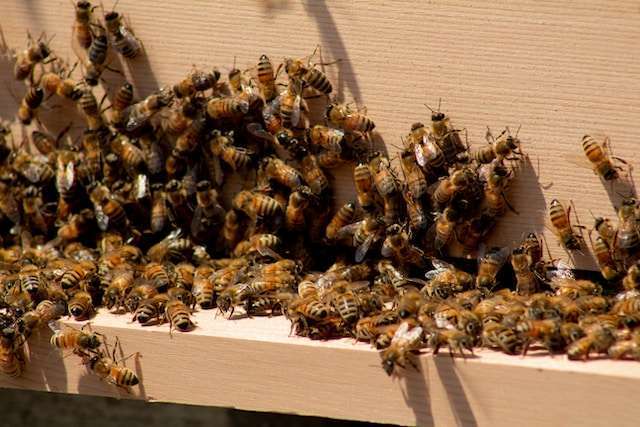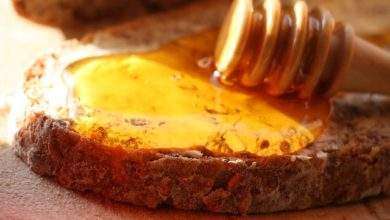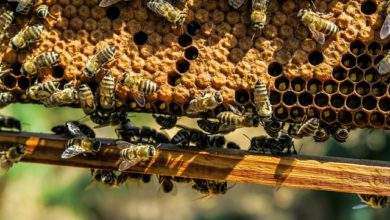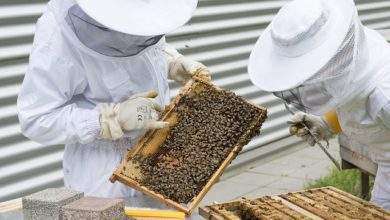Carniolan Bees versus Italian Bees: Which Bee is Right for Your Apiary?

Are you trying to decide which species of bee to choose for your apiary? As a beginner beekeeper, it can be daunting to make this choice.
There are two main types of honeybees: Carniolan bees and Italian bees. Each species has its own set of pros and cons that should be weighed carefully before making your decision.
In this article, we’ll take a look at the differences between Carniolan bees and Italian bees, consider their behavior and adaptability, discuss their needs, and ultimately help you to make the best decision for you and your apiary.
Understanding the Carniolan Bees
The Carniolan Bees, also known as Apis mellifera carnica, are a subspecies of honey bees that originated in the lush region of Carniola, Slovenia. These bees have gained recognition and popularity among beekeepers worldwide due to their distinct characteristics and unique traits.
Originating from the picturesque Carniola region of Slovenia, the Carniolan Bees have been selectively bred and developed over centuries. Beekeepers in this region have realized the remarkable qualities possessed by these bees, leading to their widespread recognition and export. Today, Carniolan Bees can be found in various parts of the world, where they continue to thrive and impress with their exceptional traits.
One of the key factors contributing to the popularity of Carniolan Bees is their excellent overwintering abilities. These bees have evolved to withstand harsh winter conditions and have a higher survival rate compared to other honey bee subspecies. Their ability to maintain a strong colony during the colder months ensures their survival and vitality, making them a preferred choice for beekeepers operating in regions with long and frigid winters.
Furthermore, Carniolan Bees are known for their gentle temperament and reduced aggression. Beekeepers appreciate their calm and docile nature, as it makes them easier to handle and work with. Their reduced aggression also means less stings and a lower risk of beekeeper-related incidents. This affable disposition is a highly sought-after trait, particularly for beekeepers who desire a more enjoyable and safer beekeeping experience.
Unlike some honey bee subspecies that struggle in cooler climates, Carniolan Bees thrive in such environments. Their natural adaptation allows them to withstand lower temperatures without compromising their productivity and overall health. This unique characteristic is particularly advantageous for beekeepers residing in areas with cooler climates, where raising other subspecies can be challenging. Carniolan Bees offer a viable solution to ensure thriving colonies even in these conditions.
Another notable trait of Carniolan Bees is their efficient use of resources and strong colony discipline. These bees are known for their diligent foraging and resource management, making them excellent honey producers. They have a remarkable work ethic and demonstrate strong organizational skills within the hive, which results in productive colonies with ample honey reserves. This efficient use of resources is not only beneficial for the bees themselves but also for beekeepers seeking high honey yields.
Exploring the Italian Bees
Italian Bees, renowned for their exceptional qualities, have gained immense popularity among beekeepers worldwide. This chapter delves into the characteristics and traits that make Italian Bees so highly coveted. From their remarkable honey production capabilities to their adaptability and strong population dynamics, Italian Bees have proven to be an invaluable asset to beekeepers.
Italian Bees are favored by beekeepers for numerous reasons, with their exceptional honey production capabilities being at the forefront. These industrious bees are renowned for their efficiency in collecting nectar and producing honey. Their dedication to foraging and their ability to locate and utilize floral resources enable them to harvest abundant amounts of nectar, resulting in high yields of delicious honey.
Another admirable trait of Italian Bees is their capacity to adapt to varied environments. Extremely versatile in nature, these bees can thrive in diverse geographical areas and climates. Whether it be the cool regions of Northern Europe or the scorching heat of Southern Africa, Italian Bees have displayed remarkable adaptability. This adaptability ensures that beekeepers in different parts of the world can successfully maintain healthy colonies, irrespective of their location.
A significant advantage of choosing Italian Bees is their rapid colony growth and strong population dynamics. These bees possess an incredible drive to reproduce and expand their colonies. This characteristic leads to a rapid increase in population, allowing beekeepers to establish strong and thriving colonies in a relatively short period. Such robust population dynamics are essential for the sustained success of a beekeeping venture.
Furthermore, Italian Bees have demonstrated a notable tolerance to certain pests, such as the varroa mite. The varroa mite is a notorious parasite that can wreak havoc on bee colonies, causing devastating losses for beekeepers. However, Italian Bees have shown a resistance to these pests, making them a preferred choice for beekeepers seeking to mitigate the harmful impacts of varroa mites. This resilience reduces the need for chemical treatments, promoting a more natural and sustainable approach to beekeeping.
Factors to Consider When Choosing Bees
Choosing the right bees for your apiary is a crucial decision that can significantly impact their survival, productivity, and your overall beekeeping experience. Factors such as climate, geographic location, the beekeeper’s experience and preferences, as well as the goals and priorities in beekeeping all play vital roles in determining the suitable bee breeds.

Climate and Geographic Location
The climate and geographic location in which your bees will reside are key considerations when selecting bee breeds. Different breeds have varying levels of tolerance to specific climates, influencing their survival and productivity.
1. Impact of climate on bee breeds:
- Each bee breed has its own unique traits that make it more or less adaptable to certain climates. While some breeds thrive in colder regions, others excel in warmer environments. It is crucial to assess the climate of your area and determine which bee breeds are better suited to it.
2. Specific requirements of Carniolan Bees and Italian Bees:
- Carniolan Bees and Italian Bees are two popular breeds with distinct characteristics that respond differently to various climates. Understanding their specific requirements will help you make an appropriate choice based on your region’s climate and geographic conditions.
Beekeeper’s Experience and Preferences:
The beekeeper’s level of experience and personal preferences should be taken into account when selecting bee breeds.
1. Influence of experience level and preferences:
- The beekeeping journey varies from beginner to intermediate and experienced levels, with individual preferences evolving along the way. The chosen bee breed should align with the beekeeper’s skill set, as well as their personal preferences in terms of handling, maintenance, and overall management.
2. Breed preferences for different beekeepers:
- In various scenarios, beginners, intermediate, or experienced beekeepers may lean towards a specific bee breed over others. Factors such as ease of handling, docility, resistance to diseases, or high honey production can influence these preferences. We will explore these scenarios to provide guidance on breed suitability based on your experience level.
Goals and Priorities in Beekeeping:
Different goals and priorities in beekeeping, such as honey production, pollination services, or genetic preservation, can significantly impact the choice of bee breeds.
1. Impact of goals on bee breed selection:
- Your primary objective in beekeeping will dictate the most suitable bee breed for your apiary. For those aiming for high honey production, certain breeds have proven to be more prolific in honey yield. Likewise, if pollination services or genetic preservation are your main goals, specific bee breeds may better serve these purposes.
2. Considerations for each bee breed regarding goals:
- Understanding how each bee breed aligns with your goals is essential. By delving into the specific considerations for each breed, such as their pollination efficiency, honey production capabilities, or genetic traits, you can make an informed decision that fulfills your beekeeping aspirations.
Conclusion
Making a decision between Carniolan bees and Italian bees can be difficult since each species has its own pros and cons. Carniolan bees are generally more peaceful and easier to manage, making them an excellent choice for beginners, while Italian bees are highly productive but require more resources and can be easily disturbed.
Ultimately, it’s up to you to decide which species is best for your apiary based on your needs and goals.
FAQ’s
What are Carniolan bees and Italian bees?
- Carniolan bees are a subspecies of honey bees (Apis mellifera carnica), originating from the region of present-day Slovenia. Italian bees (Apis mellifera ligustica) are another subspecies known for their productivity.

Which bee is more suitable for beginner beekeepers?
- Beginner beekeepers often find Carniolan bees more forgiving due to their gentle temperament. They are typically more tolerant of beginner mistakes and require less frequent inspections compared to Italian bees. This makes Carniolan bees an ideal choice for novice beekeepers.
Which bee is more productive in terms of honey production?
- Italian bees are widely regarded as the leaders in honey production. They are prolific foragers and can efficiently gather nectar, leading to larger quantities of honey compared to Carniolan bees. If honey production is your primary goal, Italian bees are a favorable choice.
Which bee is better suited for areas with unpredictable climate?
- Carniolan bees are more adaptable to harsh and unpredictable climates compared to Italian bees. Their genetic traits enable them to tolerate colder weather and thrive in areas with sudden temperature changes or erratic weather patterns.
Do Carniolan bees require less maintenance and attention?
- Carniolan bees have a reputation for requiring less frequent inspections and interventions. Due to their resource conservation behavior, they tend to consume less honey stores during winter, reducing the need for supplemental feeding. Consequently, they minimize the beekeeper’s maintenance workload.
Can I mix Carniolan and Italian bees in the same apiary?
- Yes, it is possible to have both Carniolan and Italian bees co-existing in the same apiary. However, their distinct traits and behavior may influence hive dynamics and hybridization. It’s important to consider the potential effects when managing the two subspecies together.
Are Carniolan or Italian bees better pollinators?
- Both Carniolan and Italian bees are valuable pollinators, but due to their prolific foraging nature, Italian bees tend to cover larger areas and visit more flowers, enhancing their pollination efficiency. However, the suitability for pollination largely depends on your specific location, crop requirements, and bee management practices.




